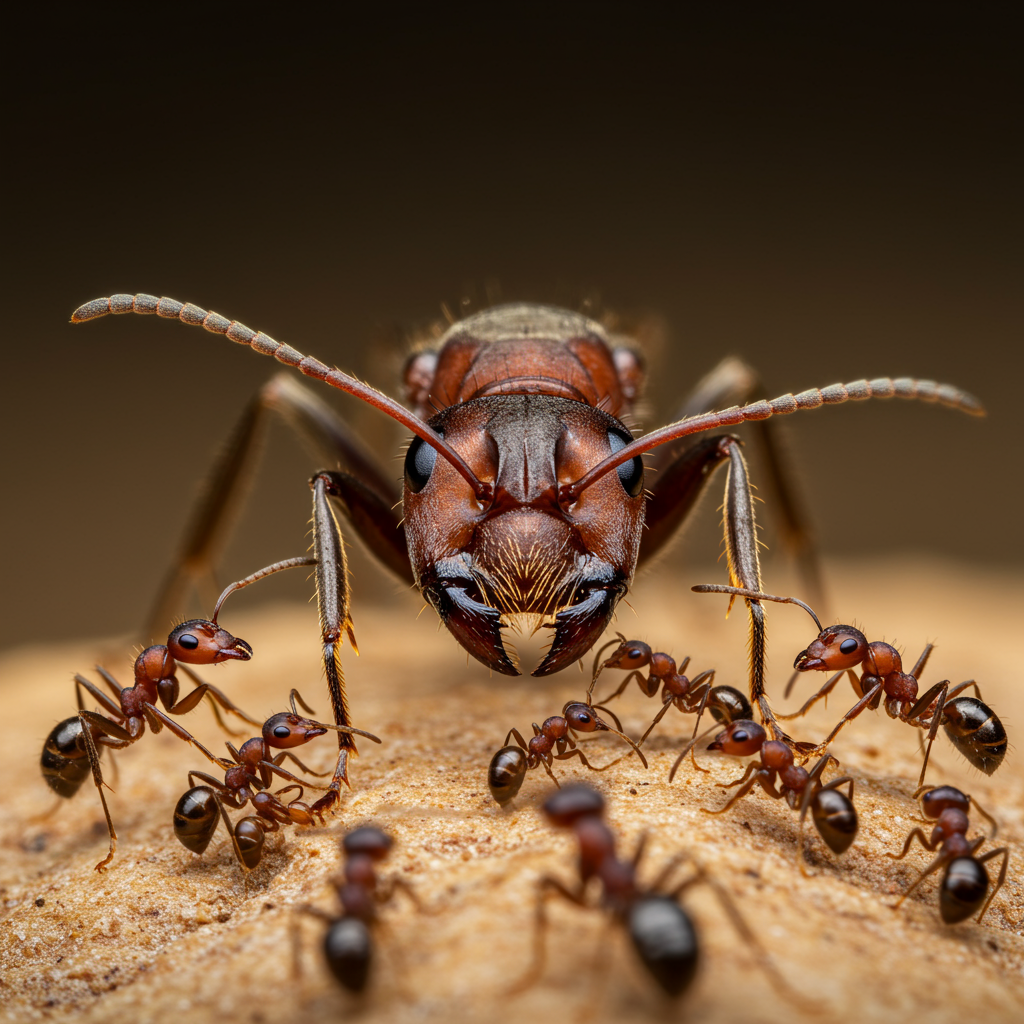Deep within the complex world of ant colonies, a truly groundbreaking discovery has redefined our understanding of family, evolution, and interspecies relationships. Imagine a queen ant, the matriarch of her vast empire, not only laying eggs for her own species but also orchestrating the birth of males from an entirely different species—males destined to mate with her own daughters. This is the astonishing reality of the Iberian harvester ant (Messor ibericus), a reproductive strategy so bizarre it initially seemed impossible. Scientists are calling it a unique evolutionary masterpiece, challenging long-held biological conventions.
The Unbelievable Discovery: A Queen and Two Species
The story begins with Jonathan Romiguier, a researcher at the University of Montpellier in France. His intrigue sparked when he noticed something peculiar about the workers in Messor ibericus nests: they were all hybrids. Their DNA showed a clear split, with roughly half originating from M. ibericus and the other half from a distinct species, the builder harvester ant (Messor structor). This immediately suggested interspecies mating, a known, though uncommon, phenomenon in the insect world. However, Romiguier’s subsequent findings would push the boundaries of what was thought possible.
Initial hypotheses for this cross-species breeding focused on two main ideas. One theory suggested hybrid vigour, where combining genes from two closely related species might create stronger, more resilient offspring, compensating for any genetic weaknesses. The second, more specific, idea pointed to a genetic quirk unique to M. ibericus. When M. ibericus queens mated solely with M. ibericus males, all their offspring would inexplicably turn into queens. This scenario would be “devastating for the colony,” as it relies heavily on sterile female workers for survival and maintenance. Interspecies breeding, therefore, could be a clever workaround, enabling the production of essential workers.
The Mystery Deepens: Males Where They Shouldn’t Be
The puzzle, however, intensified with an environmental observation. M. ibericus colonies thrive across vast Mediterranean regions, including places like Sicily, where M. structor colonies simply do not exist. Despite this geographical isolation, “odd-looking, hairless M. structor males” were consistently found within M. ibericus nests in these very areas. If M. ibericus queens were simply mating with wild M. structor males, how could these males appear in regions where their species was absent? The answer lay hidden in the queens themselves.
The breakthrough arrived with meticulous genetic analysis. Researchers examined the mitochondrial DNA (mtDNA) of these unusual M. structor males. MtDNA is inherited exclusively from the mother. Astonishingly, the mtDNA of these males was found to be M. ibericus. This was irrefutable proof: an M. ibericus queen was their mother, despite their otherwise M. structor genetic makeup. To confirm this truly “crazy” discovery, Romiguier embarked on an arduous two-year laboratory experiment, observing dozens of M. ibericus colonies until, finally, the birth of three M. structor males in the lab provided definitive, tangible evidence.
The Sophisticated Strategy: How the Queen Pulls It Off
The mechanism behind this evolutionary marvel is as intricate as it is ingenious. Messor ibericus queens employ a two-pronged reproductive strategy, utilizing stored sperm from M. structor males in a unique way. When a queen lays an egg destined to become one of these “rental” M. structor males, she effectively clones the M. structor sperm stored within her spermatheca. These resulting eggs develop into males that are almost entirely devoid of her M. ibericus DNA, with the singular exception of the mitochondrial DNA, which, as established, is maternally inherited from her egg. This makes her, in essence, a “rental womb” for another species’ sons.
This complex strategy ensures the perpetuation of the M. ibericus colony. The queen uses sperm from M. ibericus males to produce new M. ibericus queens, ensuring her own lineage continues. Simultaneously, she employs M. structor sperm to generate two critical components: the essential hybrid female workers who build and maintain the colony, and new clonal M. structor males. These clonal males then mate with the M. ibericus daughters (who are themselves hybrid queens), ensuring a continuous supply of the hybrid workers vital for survival.
A Unique Evolutionary Arrangement: Mutual Dependence
This represents a biological first: the only known instance where males and females from different species are entirely dependent on each other for reproduction. The M. ibericus queen relies completely on her clonal M. structor males to produce the workers necessary for the colony’s very existence. Conversely, these clonal M. structor males are beholden to M. ibericus queens for their own reproduction, and to the hybrid workers for the overall viability of the colony. There is no evidence that these clonal males mate with non-clonal M. structor ants in the wild.
This unique interdependence highlights evolution’s capacity for extreme ingenuity. While some cases exist where a female’s eggs are hijacked by another species’ sperm for the male’s benefit, this scenario differs fundamentally. Here, the queen is actively facilitating the cloning of another species’ males for her own colony’s survival, demonstrating a mutual, symbiotic relationship across species lines.
Broader Implications and Evolutionary Parallels
The findings, published in Nature, have convinced other experts, with Nathan Lo of the University of Sydney commending the “rigorous study” and strong supporting evidence. This extraordinary case dramatically illustrates that evolution often disregards conventional “rules,” such as parents only producing offspring of their own species or colonies maintaining a single lineage. This “two-species household” managed by a single queen in southern Europe profoundly redefines the concept of “family” in the natural world.
Interestingly, this ingenious strategy is not the only example of ants employing unusual reproductive tactics to overcome genetic hurdles. Consider the longhorn crazy ant (Paratrechina longicornis), an invasive species with a unique cloning mechanism that allows queens to mate with their brothers without suffering the detrimental effects of inbreeding. In this species, daughter queens are genetic clones of the mother, and reproductive males are genetic clones of the father, effectively bypassing genetic mixing that could lead to inbreeding depression. While Messor ibericus‘s strategy involves interspecies cloning, both demonstrate how evolution finds ways to maintain genetic fitness despite seemingly disadvantageous reproductive choices.
One potential concern, as raised by Nathan Lo, is that the clonal males’ lack of genetic mixing could lead to a buildup of harmful mutations over time. This could potentially cause the lineage to deteriorate, especially in changing environments. Romiguier acknowledges this possibility, agreeing that the “peculiar situation might eventually collapse.” Yet, for now, this extraordinary interspecies relationship has proven remarkably successful, allowing M. ibericus to flourish across vast Mediterranean territories, even where wild M. structor colonies are absent. This incredible resilience speaks volumes about the adaptive power of this complex, multi-species strategy, allowing the Iberian harvester ant to thrive against the odds.
Frequently Asked Questions
What is the most astonishing aspect of the Iberian harvester ant’s reproduction?
The most astonishing aspect is that a single Messor ibericus queen produces not only hybrid female workers (from mating with Messor structor males) but also lays eggs that develop into cloned males of the Messor structor species. These cloned M. structor males then mate with the queen’s M. ibericus daughters, ensuring the colony’s supply of essential hybrid workers. This makes the M. ibericus queen a “rental womb” for another species’ sons, a phenomenon previously thought impossible.
Why do Messor ibericus queens engage in this complex interspecies breeding strategy?
Messor ibericus queens rely on this strategy primarily to produce female workers, which are crucial for the colony’s survival. Researchers hypothesize that a genetic quirk means if M. ibericus queens only mated with M. ibericus males, all offspring would be queens, leaving no workers. By mating with Messor structor males and cloning them, the queen ensures the production of hybrid workers and new males of M. structor to continue this cycle, effectively circumventing a devastating genetic outcome for her colony.
Are there any potential long-term risks for the Messor ibericus lineage due to this unique reproduction?
Yes, experts like Nathan Lo have raised concerns about the long-term viability of this strategy. Because the Messor structor males are essentially clones, they lack genetic mixing. Over extended periods, this could lead to an accumulation of harmful mutations that are not weeded out by natural selection. This genetic stagnation might eventually weaken the lineage, potentially causing the “peculiar situation to collapse,” especially if environmental conditions change significantly. However, for now, the strategy has proven highly successful.
Conclusion
The discovery of the Iberian harvester ant’s reproductive strategy is a testament to the boundless creativity of evolution. This single ant queen, orchestrating a two-species household, fundamentally rewrites our understanding of genetic inheritance, interspecies cooperation, and the definition of family in nature. It highlights how life, driven by the imperative to survive and reproduce, can devise solutions that are as elegant as they are utterly bizarre. As scientists continue to unravel such mysteries, we are reminded that the natural world holds an endless supply of wonders, constantly challenging our preconceptions and pushing the boundaries of biological possibility.




